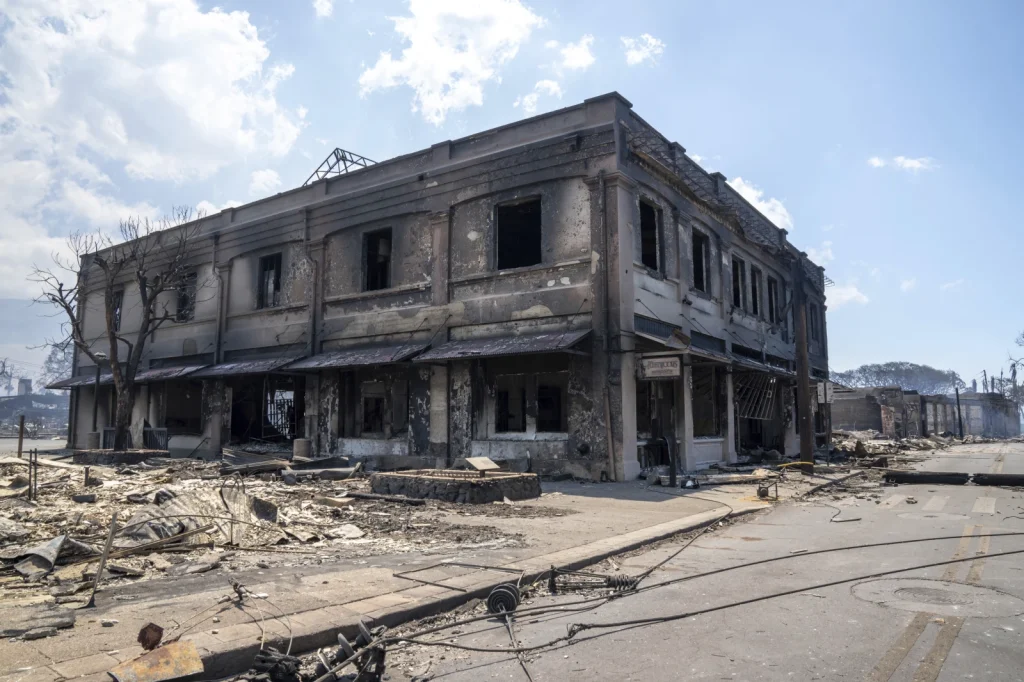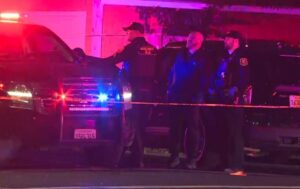Survivors of Maui’s wildfires return home to blackened ruins, death toll rises to 67

Lahaina, The Gulf Observer: Blackened hulks of burned-out cars, the pavement streaked with melted and then rehardened chrome. Block after block of flattened homes and businesses. Incinerated telephone poles, and elevator shafts rising from ashy lots where apartment buildings once stood. A truck bed full of glass bottles, warped into surreal shapes by the furious heat.
Anthony Garcia assessed the devastation as he stood under historic Lahaina’s iconic banyan tree, now charred, and swept twisted branches into neat piles next to another heap filled with dead animals — cats, roosters and other birds killed by the smoke and flames. Somehow it made sense in a world turned upside-down.
“If I don’t do something, I’ll go nuts,” said Garcia, who lost everything he owned. “I’m losing my faith in God.”
That was the scene residents found when they were allowed back home to take stock of their shattered homes and lives Friday as the toll rose to 67 confirmed dead in this week’s wildfires, which tore through parts of Maui and were still short of full containment and being battled by firefighters.
Attorney General Anne Lopez’s office announced it will conduct a comprehensive review of decision-making and standing policies leading up to, during and after the wildfires.
“My Department is committed to understanding the decisions that were made before and during the wildfires and to sharing with the public the results of this review,” Lopez said in a statement. “As we continue to support all aspects of the ongoing relief effort, now is the time to begin this process of understanding.”
Associated Press journalists also witnessed the devastation, with nearly every building destroyed on Front Street, the heart of Lahaina and the economic hub of the island. Surviving roosters, which are known to roam Hawaii streets, meandered through the ashes, and there was an eerie traffic jam of charred cars that didn’t escape the inferno.
“It hit so quick, it was incredible,” resident Kyle Scharnhorst said as he surveyed his apartment complex’s damage in the morning. “It was like a war zone.”
The wildfires are the state’s deadliest natural disaster in decades, surpassing a 1960 tsunami that killed 61 people. An even deadlier tsunami in 1946, which killed more than 150 on the Big Island, prompted the development of the territory-wide emergency system that includes sirens, which are sounded monthly to test their readiness.
But many fire survivors said in interviews that they didn’t hear any sirens or receive a warning that gave them enough time to prepare, realizing they were in danger only when they saw flames or heard explosions nearby.
“There was no warning. There was absolutely none. Nobody came around. We didn’t see a fire truck or anybody,” said Lynn Robinson, who lost her home.
Hawaii emergency management records show no indication that warning sirens sounded before people had to run for their lives. Instead, officials sent alerts to mobile phones, televisions and radio stations — but widespread power and cellular outages may have limited their reach.
Maui water officials warned residents in Kula and Lahaina who have running water that it may be contaminated and they should not drink it — even after boiling — and should take only short, lukewarm showers “in a well-ventilated room” to avoid exposure to possible chemical vapors.
But Andrew Whelton, an engineering professor at Purdue University whose team was called in after the Camp Fire and the 2021 Marshall Fire in Colorado, said “showering in water that potentially contains hazardous waste levels of benzene is not advisable” and a do-not-use order would be appropriate until sampling and analysis have been done.
When she fled Tuesday, Lahaina resident Lana Vierra thought it would be temporary. She spent Friday morning filling out FEMA assistance forms at a relative’s house in Haiku.
Though she knew the home where she raised five children was gone, along with treasured items like baby pictures and yearbooks, she was eager to return.
“To actually stand there on your burnt grounds and get your wheels turning on how to move forward — I think it will give families that peace,” she said.
Riley Curran said he fled his home on Front Street after climbing up a neighboring apartment building to get a better look at the onrushing fire. He doubts county officials could have done more to stave off disaster, because it happened so fast.
“It’s not that people didn’t try to do anything. … The fire went from 0 to 100,” Curran said.
Curran added that he grew up in California and has seen horrendous wildfires, but “I’ve never seen one eat an entire town in four hours.”


